- Building and Landscaping, Compost, Gardening adventures, Hugelkultur, Irrigation and Watering, Permaculture and Edible Forest Gardening Adventures, Rain Catching, Soil, Water, Water Saving, Worms
Earthworks Workshop
Happy March! Finch Frolic Garden is officially open, and the trees are bursting into leaf and bloom. Birds are twitterpating and the ten inches of rain we’ve received since October are slowly working through the soil thanks to our earthworks.
Here’s an opportunity to learn just how to create accurate swales and hugelkultur so that they work. Saturday March 11th from 1 -4 we have the privilege of having Alden Hough from Sky Mountain Permaculture hold our first monthly workshop here in the garden. Alden has
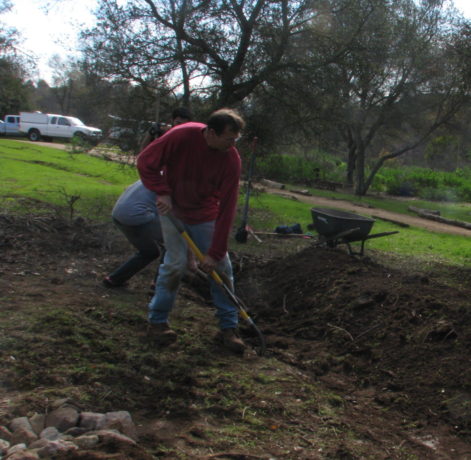 years of experience with building earthworks on all scales, from guiding excavators across hillsides to hand-dug. Alden will describe how to build swales and hugelkultur beds, show off equipment, and then its hands-on in the garden. You’ll learn how to use a laser level and a bunyip, and get the feel of how to build on contour. Bring your gloves and be prepared to have some fun creating earthworks, so that you can do it properly on your own property.
years of experience with building earthworks on all scales, from guiding excavators across hillsides to hand-dug. Alden will describe how to build swales and hugelkultur beds, show off equipment, and then its hands-on in the garden. You’ll learn how to use a laser level and a bunyip, and get the feel of how to build on contour. Bring your gloves and be prepared to have some fun creating earthworks, so that you can do it properly on your own property.The workshop fee is $20/person. Please RSVP to dianeckennedy@prodigy.net. Wear appropriate work clothes and sun protection. Complimentary vegetarian refreshments will be available. Attendees may stroll Finch Frolic Garden as well. Don’t wait!
- Arts and Crafts, Gardening adventures, Hugelkultur, Permaculture and Edible Forest Gardening Adventures, Soil
Bunyips: Fun to Say, Easy to Make and Use
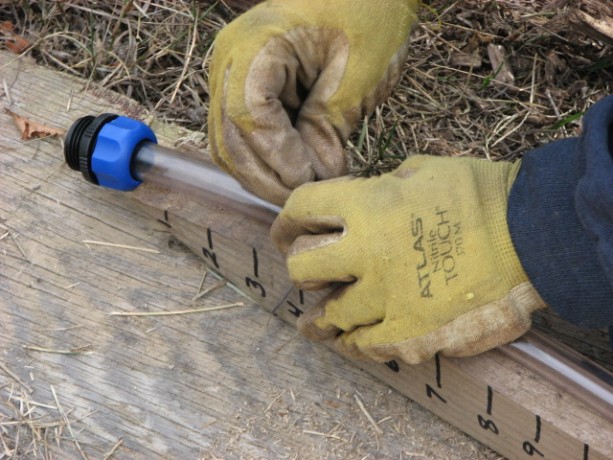
Making a bunyip. Hi! I’m back. Its not as though I’ve been vacationing. Someday I might tell you about how important it is to question your doctor, about how under-producing thyroids affect every part of your body, about neighbor’s in-laws who skip their meds for a day and crash through your gate, and about strange and fatal chicken illnesses, but not today.
My big garden project for the winter is to turn the raised vegetable bed area into a sunken hugelkultur sheet-mulched vegetable area. I’ll go into details about that in another post as well. What I am going to describe is how to take measurements using a bunyip.
A bunyip is a water level that you can make very inexpensively and quickly, which relies upon gravity to give a reading. It even works around corners. I really don’t know how it came to be called a bunyip… its an Australian thing. A bunyip is an ancient aborigine water monster. More recently the name has come to be synonymous with imposter. Maybe this simple home-made water level is impersonating a laser level. Maybe bunyip is just so gosh-darn more fun to say.
Anyway, if you need to measure the difference in elevation, use a bunyip. If you want to find level ground, for instance if you are building a level swale on contour, use a bunyip.
The equipment for your bunyip are: two slim boards with at least one end flat, and at least 5 feet tall. You also need about 30 feet of clear fishtank hose. A waterproof marker, a ruler, a level and six pieces of wire to tie around the posts, and you are ready to go. If you have a couple of corks or stoppers that fit in the tops of the tubing, it will make it easier to carry without receiving a surprise shower.
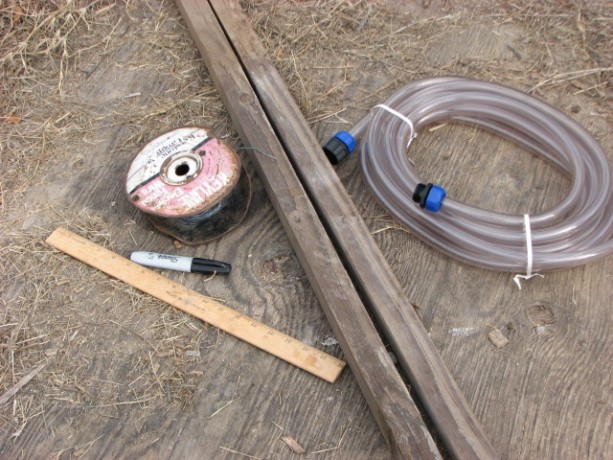
You will need two slim posts, 30′ of tubing (the only kind I could buy in town was for cleaning fishtanks, hence the threaded ends. You don’t need these!), a ruler, wire and a waterproof marker. Be sure at least one of the ends of each board is flat, which will be what touches the earth when measuring. Along one of the boards begin to mark off inches (or centimeters) from the top. Make the marks readable from a short distance. Number the inches beginning with 1 at the top of the post, down to at least four feet (if you are measuring more dramatic slopes you’ll want to mark off more). Numbering from the top down allows you to do simple subtraction easily without becoming mixed-up, especially when you’re tired.
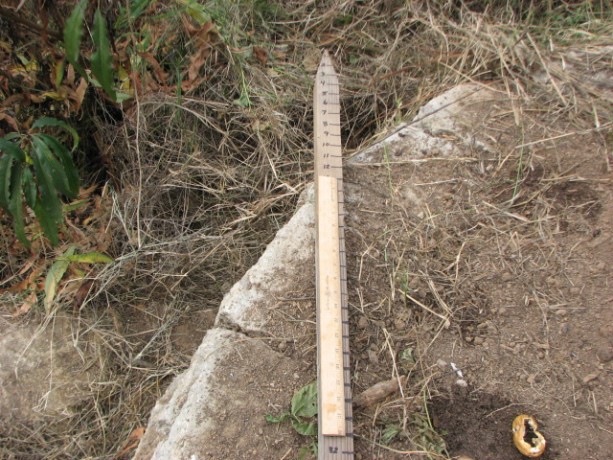
Using a ruler or yardstick (or meterstick), mark inches down from the top of the post. Next, stand the two posts together on level ground, making sure they are straight. It doesn’t matter if the tops aren’t exactly even, just the bottoms. Now with the two posts standing on even ground, mark the second post in one spot evenly with a mark on the first post; it doesn’t really matter which inch you mark because you can then use the ruler to fill in all the others.

With the bottoms of each post level, begin to mark the second post from the top, even if the tops of the posts aren’t even. So, using that mark and a ruler, mark inches all along the second post. The point is that the measurements are even from the bottom of the posts, where they will be resting on the ground.
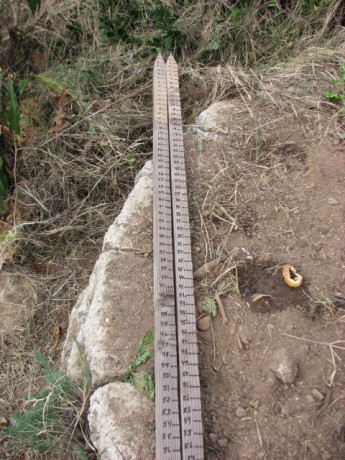
You will have two posts with inches marked from the top. That done, tie the tubing onto the posts, allowing the tubing to reach a little higher than the top of the posts. The tubing in the photo is all I could find in town, and it is an extension for a fish tank cleaner, hence the threaded ends. You don’t need threaded ends, just the tubing.

Wire the tubing onto the posts, allowing the top of the tubing to be above the top of the post. With the tubing tied to the marked posts, you are almost ready to measure. Having someone to hold a post really helps here. With both posts straight up, fill the tubing with water. You can use a watering can (with the spray end off), or a hose. A funnel might help. Fill the tubing as completely as you can, but don’t worry about having the water go end to end. A gap at either end is okay.
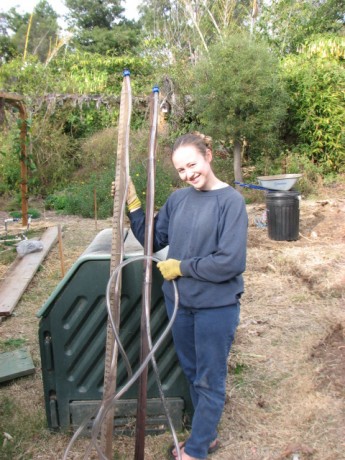
Miranda holding the completed and filled bunyip. Work the air bubble out of the hose by lifting the bottom. Take out the air bubbles by lifting the center of the hose and feeding the air bubble through.
You are ready to measure!
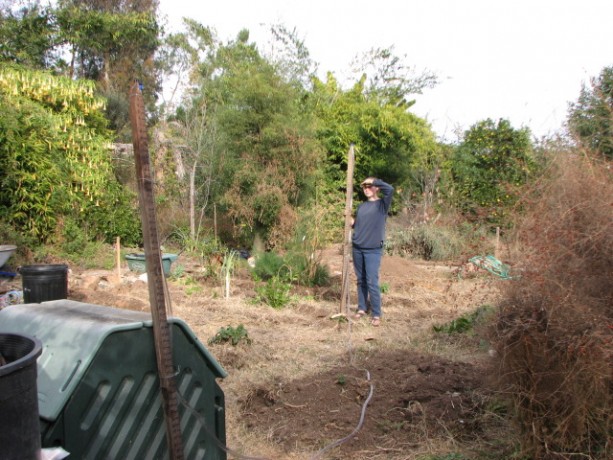
The tubing doesn’t need to be off the ground to work; it can even work around corners. One person stands with their side of the bunyip at one area you want to measure, and the other person stands at the other. You don’t need to make the tubing lift off the ground; it will accurately measure with the tubing in almost any position. The water in the tubing will bob around; tap the top of the tubing with your finger to help it settle faster.
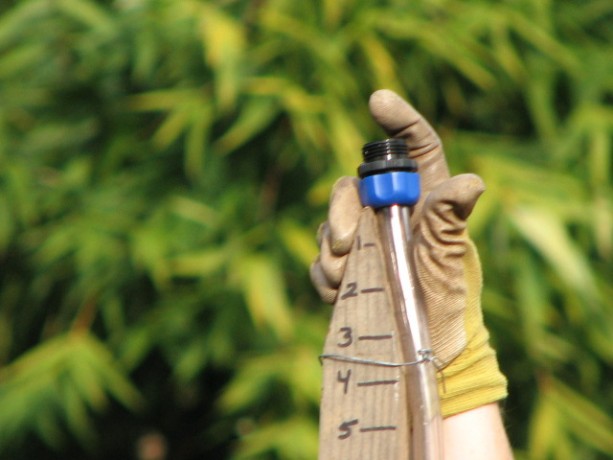
Tapping on the end helps make the water settle faster. Then take the readings from each post. Subtract the readings and you will get the distance in elevation between the two points. For instance, if the water level on one post is at the 19″ mark, and the water level on the other post is at the 7″ mark, then there is a 12″ difference in elevation between the two points. So easy!
If you are building swales on contour, keep moving one side of the bunyip until you find a spot where both readings are even, then mark those spots and repeat farther on. In this way you can find what land is level.
My daughter and I used our bunyip today to measure the change in elevation in our vegetable bed. We won’t be leveling the bed itself, but we will be digging deep, level swales, and we now know just how radically, and in which direction, our slope lies. This reaffirms what our eyes tell us about how rainwater flows across the veggie area and therefore how we’re to dig the swales to best catch rainfall.
Best of all, bunyips can be quickly disassembled and the parts used for other projects, or emptied and carried to other locations. Just add water, and you get a bunyip!
-
Tiny Hugels and Fishscale Swales: Small water catchment
In permaculture it is recommended to design long level, contoured swales throughout your property to catch rainwater. Long swales, however, won’t work when the property is small, or if it is already mostly planted, or if the hiring of large equipment or teams of diggers isn’t feasable, or if long swales aren’t part of a lovely garden. What then?
In the gardens for which I’ve written consultations I’ve recommended what Geoff Lawton (of the Permaculture Design Institute of Australia) calls fishscale swales. Small curved swales staggered up a slope so that rainwater can be caught and held. One overflows into another, just like a pinball machine.
Any swale, no matter how small, will help hold water. I put them in just above each plant, the width of the dripline of the plant. I also combine them with burying wood (hugelkultur). I don’t have a lot of branches or logs, but I do have a lot of extra pieces of lumber salvaged when the sheds were dismantled. These pieces are untreated (no paint or pressure treatment), and if they have nails and screws in them, even better! The hardware will mineraize the soil as it decomposes. This wood is already very old and dry, and thus will soak up water a treat. If you soak the wood in water, compost tea or a microbial brew before you bury it, that’s super. If not, don’t worry about it. The idea is that rainwater will accumulate in the swale, percolate into the soil and into the wood below it. There the wood will hold water as it breaks down, gradually irrigating and fertilizing the plant below.
Wood can be placed on top of the soil and buried as the swale is dug, or it can be dug into the ground and covered. The swale is filled with mulch o help retard weed growth; if by a walkway the scale filled with mulch then it may be walked on without fear of a twisted ankle.
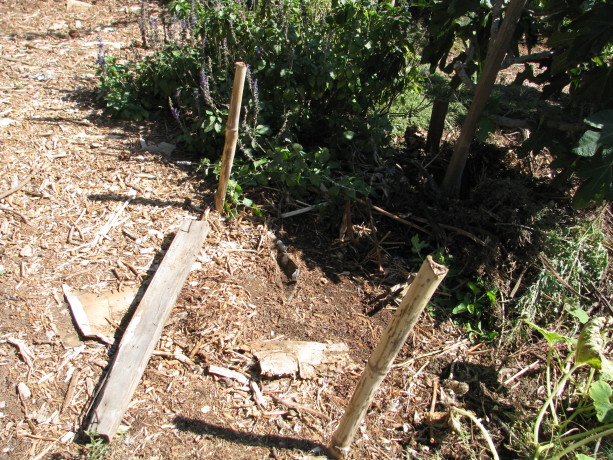
This area right above the fig is small, but large enough to catch water. Here I have a Mission fig that has been slow to grow due to irregular watering (NOT my fault!)
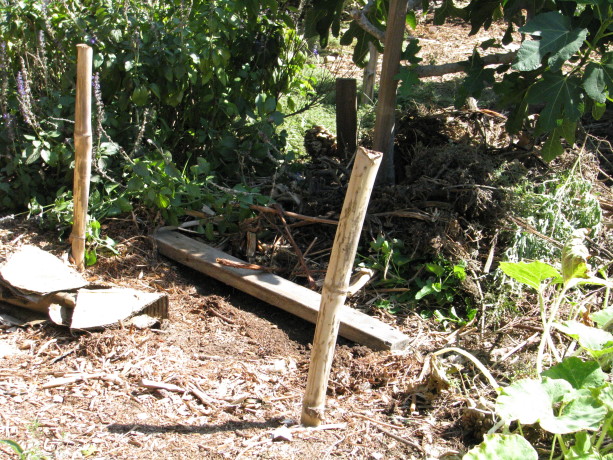
I laid out a board right on the ground. Figs like a little water and this area has been on the dry side. In the direction from which rainwater would flow, above the tree, I laid out a few pieces of old lumber, nails and all.
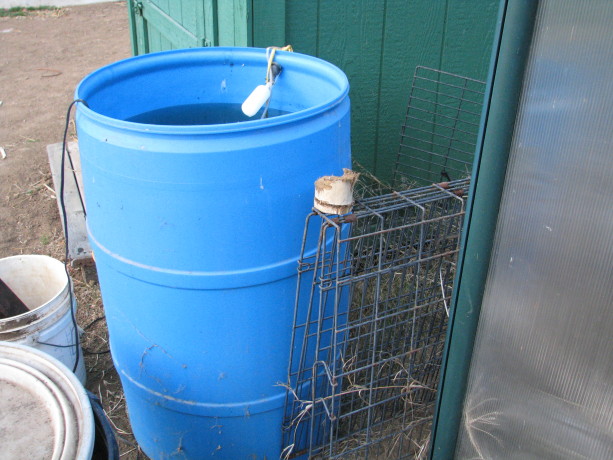
Brewing microbial tea. I happened to be brewing a large batch of microbial tea, so I threw the wood into a bucket of the stuff and let it absorb some.

I soaked the wood in microbial tea for a few minutes. They happen to be the width of the existing dripline of the tree; again, any swale and and wood will help. I dug a small swale the same length, a shovel’s width wide, and threw the dirt on top of the wood.
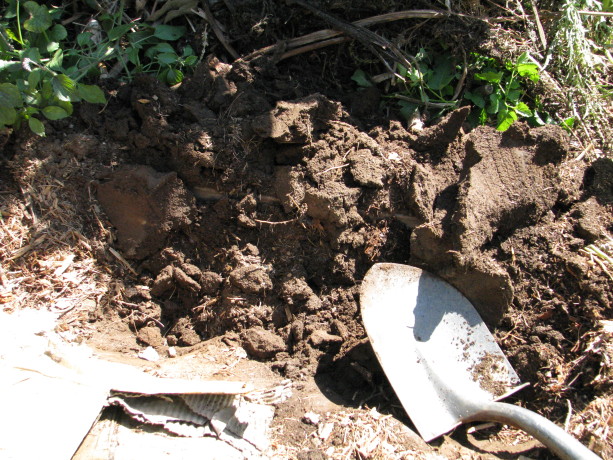
I dug a swale, using the dirt to cover the board. Then I filled the swale with mulch and voila! the job is done. This will now catch rainwater, hold moisture, and fertilize the tree, as well as finding something useful for junk lumber. Burying the wood sequesters the gasses released in decomposing materials into the soil rather than the air thus helping reduce greenhouse gasses.
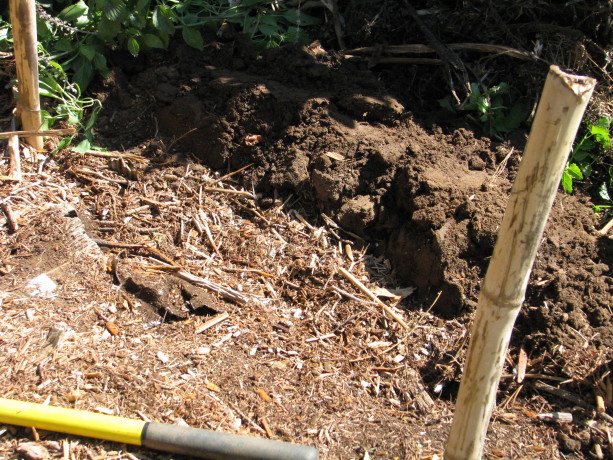
I filled the swale with mulch to keep down weeds. Presto! Done! Using fishscale swales and mini-hugelkultur beds when planting most native plants can really help them become established in a low-water situation. This wild rose (rosa rugusa) is being planted in a very dry area, and I wanted to bury the wood below soil level to keep it closer to the roots of the plant. I dug a small trench and laid out some boards, nails down.
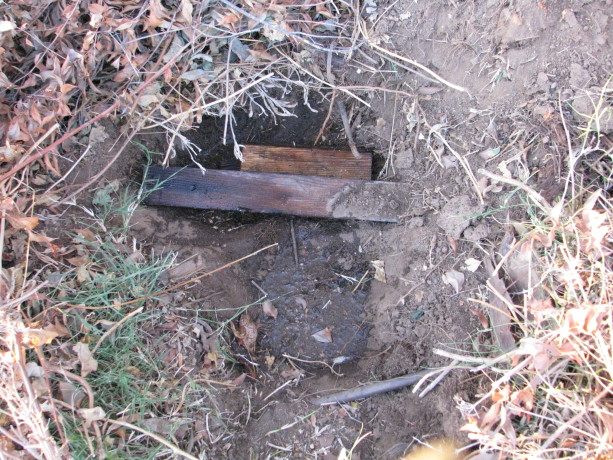
I dug a little ways into the dirt and laid out the soaked wood. Then as I dug the swale I layered the wood with dirt and a couple more boards until buried. I filled in the swale with mulch and planted the rose on the downhill side.
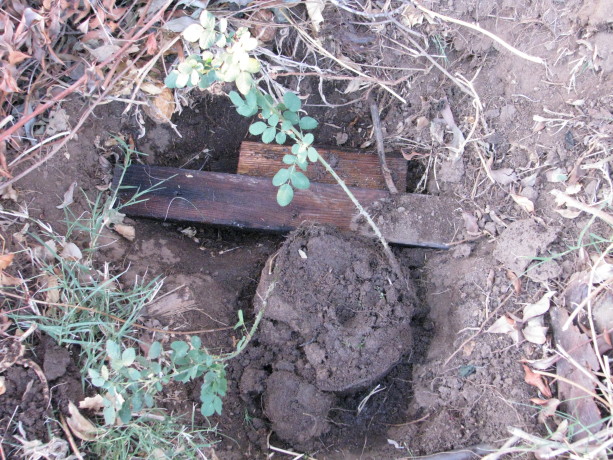
Here you’ll see the rootball of the new wild rose in front of the wood. I threw in some coyote scat since it was lying there so conveniently. There’s quite a microbial boost for the rose!

Some coyote scat went in, too. Sorry! Remember that here in a dry climate we need to plant so that the root ball is even with the ground, or make the whole catch basin a little lower. Otherwise the roots will dry out. Planting so that the root ball is a little above the ground is a common practice is rainy areas.
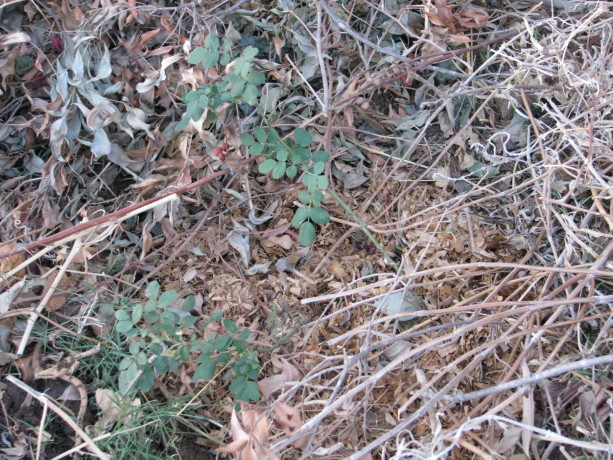
Here is the planted rose, with mulch pulled up around it. Remember native plants have communities. Certain plants grow with certain others because they are mutually beneficial. This rose was planted within the dripline of an Engelmann oak, one place it is found.
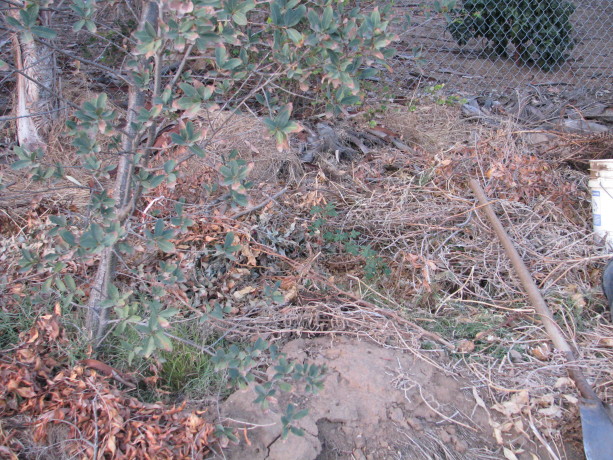
Many native trees like the company of other natives. I planted this rose just outside the dripline of this oak, one of the places it would naturally grow in the wild. So swales don’t have to be gigantic earthworks projects. They can be small and alternated down a slope, or just individual ones above new or existing plants. Throw some wood into a mini-hugel between the swale and the plant and you’ll water less, fertilize naturally, and compost leftover wood. Don’t forget cotton clothing and bedding… that all works, too!
.